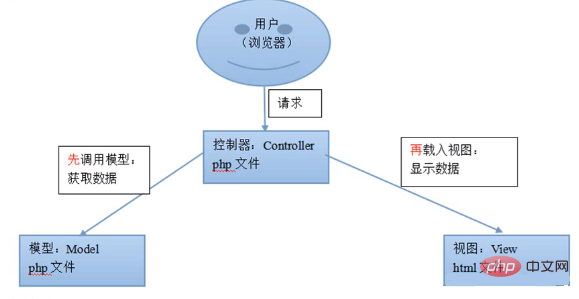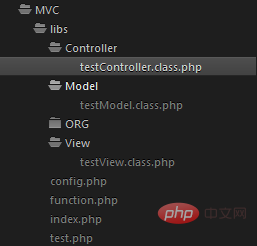PHP - MVC pattern explanation and examples
1. MVC pattern flow chart

##2. MVC concept
(1) Function MVC includes Controller, Model, and View. The function of the controller is to call the model and the view, pass the data generated by the model to the view, and let the view display it The function of the model is to obtain the data and process the returned data The function of the view is to beautify the obtained data and output it to the user terminal (2) Execution process1. Viewer-> Call the controller and issue instructions2. Controller-> Select the appropriate model according to the command3. Model-> Get data according to the command4. Controller-> Select the view according to the command 5 . View -> Display the obtained data3. Simple MVC example
(1) Directory planning
1. testController.class.php Controller class file
<!--
首先实例化控制器对象,并调用指令方法,
方法里面实例化模型对象,调用取数据方法
并实例化视图对象,调用展示方法
-->
<!--
控制器的方法没有参数,而其他的就有参数
-->
<?php
// 类名和文件名相同
class testController{
function show(){
$testModel = new testModel();//按指令选择一个模型
$data = $testModel -> get();//模型按照指令取数据
//按指令选择视图 实例化一个view的对象
$testView = new testView();
//把取到的数据按用户的样子显示出来
$testView -> display($data);
}
}
?> Naming rules: test (model file name) Model ( Model file).class.php Class file
<?php
class testModel{
//获取数据
function get(){
return "hello world";
}
}
?><?php
class testView{
//展示数据
function display($data){
echo $data;
}
}
?><?php //引入类文件 require_once('/libs/Controller/testController.class.php'); require_once('/libs/Model/testModel.class.php'); require_once('/libs/View/testView.class.php'); //类的实例化 $testController = new testController();//对象赋值给变量 $testController->show();//调用方法 ?>

4. Simple MVC instance improvement----Method Encapsulation
1. Encapsulate an object that instantiates a controller, etc. and a function that calls a method<?php
//控制器名字和要执行的方法
function C($name,$method){
require_once('/libs/Controller/'.$name.'Controller.class.php');
//对象赋值给变量
// $testController = new testController();
// $testController->show();
eval('$obj = new '.$name.'Controller();$obj->'.$method.'();');//把字符串转换为可执行的php语句
}
//封装一个实例化模型的对象和调用方法的函数
function M($name){
require_once('/libs/Model/'.$name.'Model.class.php');
//$testModel = new testModel();
eval('$obj = new '.$name.'Model();');//实例化
return $obj;
}
//封装一个实例化视图的对象和调用方法的函数
function V($name){
require_once('/libs/View/'.$name.'View.class.php');
//$testView = new testView();
eval('$obj = new '.$name.'View();');
return $obj;
}
//为了安全性 ,过滤函数
//addslashes对’,字符进行转义
//get_magic_quotes_gpc()当前魔法符号的打开状态,打开返回true,
function daddslashes($str){
return (!get_magic_quotes_gpc() )? addslashes($str) : $str;
}
?><?php require_once('function.php'); //允许访问的控制器名和方法名的数组 $controllerAllow=array('test','index'); $methodAllow =array('test','index','show'); //用get方式接收url中的参数 //过滤输入非法字符 并判断是否在数组里 $controller = in_array($_GET['controller'],$controllerAllow )? daddslashes($_GET['controller']) :'index' ; $method = in_array($_GET['method'],$methodAllow) ? daddslashes($_GET['method']) :'index'; //调用控制器和执行方法 C($controller,$method); ?>

The above is the detailed content of PHP - MVC pattern explanation and examples. For more information, please follow other related articles on the PHP Chinese website!

Hot AI Tools

Undresser.AI Undress
AI-powered app for creating realistic nude photos

AI Clothes Remover
Online AI tool for removing clothes from photos.

Undress AI Tool
Undress images for free

Clothoff.io
AI clothes remover

Video Face Swap
Swap faces in any video effortlessly with our completely free AI face swap tool!

Hot Article

Hot Tools

Notepad++7.3.1
Easy-to-use and free code editor

SublimeText3 Chinese version
Chinese version, very easy to use

Zend Studio 13.0.1
Powerful PHP integrated development environment

Dreamweaver CS6
Visual web development tools

SublimeText3 Mac version
God-level code editing software (SublimeText3)

Hot Topics
 PHP MVC Architecture: Building Web Applications for the Future
Mar 03, 2024 am 09:01 AM
PHP MVC Architecture: Building Web Applications for the Future
Mar 03, 2024 am 09:01 AM
Introduction In today's rapidly evolving digital world, it is crucial to build robust, flexible and maintainable WEB applications. The PHPmvc architecture provides an ideal solution to achieve this goal. MVC (Model-View-Controller) is a widely used design pattern that separates various aspects of an application into independent components. The foundation of MVC architecture The core principle of MVC architecture is separation of concerns: Model: encapsulates the data and business logic of the application. View: Responsible for presenting data and handling user interaction. Controller: Coordinates the interaction between models and views, manages user requests and business logic. PHPMVC Architecture The phpMVC architecture follows the traditional MVC pattern, but also introduces language-specific features. The following is PHPMVC
 An advanced guide to PHP MVC architecture: unlocking advanced features
Mar 03, 2024 am 09:23 AM
An advanced guide to PHP MVC architecture: unlocking advanced features
Mar 03, 2024 am 09:23 AM
The MVC architecture (Model-View-Controller) is one of the most popular patterns in PHP development because it provides a clear structure for organizing code and simplifying the development of WEB applications. While basic MVC principles are sufficient for most web applications, it has some limitations for applications that need to handle complex data or implement advanced functionality. Separating the model layer Separating the model layer is a common technique in advanced MVC architecture. It involves breaking down a model class into smaller subclasses, each focusing on a specific functionality. For example, for an e-commerce application, you might break down the main model class into an order model, a product model, and a customer model. This separation helps improve code maintainability and reusability. Use dependency injection
 Uncovering the success of the SpringMVC framework: why it is so popular
Jan 24, 2024 am 08:39 AM
Uncovering the success of the SpringMVC framework: why it is so popular
Jan 24, 2024 am 08:39 AM
SpringMVC framework decrypted: Why is it so popular, specific code examples are needed Introduction: In today's software development field, the SpringMVC framework has become a very popular choice among developers. It is a Web framework based on the MVC architecture pattern, providing a flexible, lightweight, and efficient development method. This article will delve into the charm of the SpringMVC framework and demonstrate its power through specific code examples. 1. Advantages of SpringMVC framework Flexible configuration method Spr
 How to implement the MVC pattern using PHP
Jun 07, 2023 pm 03:40 PM
How to implement the MVC pattern using PHP
Jun 07, 2023 pm 03:40 PM
The MVC (Model-View-Controller) pattern is a commonly used software design pattern that can help developers better organize and manage code. The MVC pattern divides the application into three parts: Model, View and Controller, each part has its own role and responsibilities. In this article, we will discuss how to implement the MVC pattern using PHP. Model A model represents an application's data and data processing. usually,
 How to implement scalable MVC architecture in PHP8 framework
Sep 11, 2023 pm 01:27 PM
How to implement scalable MVC architecture in PHP8 framework
Sep 11, 2023 pm 01:27 PM
How to implement a scalable MVC architecture in the PHP8 framework Introduction: With the rapid development of the Internet, more and more websites and applications adopt the MVC (Model-View-Controller) architecture pattern. The main goal of MVC architecture is to separate different parts of the application in order to improve the maintainability and scalability of the code. In this article, we will introduce how to implement a scalable MVC architecture in the PHP8 framework. 1. Understand the MVC architecture pattern. The MVC architecture pattern is a software design
 How to use MVC architecture to design projects in PHP
Jun 27, 2023 pm 12:18 PM
How to use MVC architecture to design projects in PHP
Jun 27, 2023 pm 12:18 PM
In Web development, MVC (Model-View-Controller) is a commonly used architectural pattern for processing and managing an application's data, user interface, and control logic. As a popular web development language, PHP can also use the MVC architecture to design and build web applications. This article will introduce how to use MVC architecture to design projects in PHP, and explain its advantages and precautions. What is MVCMVC is a software architecture pattern commonly used in web applications. MV
 Developing MVC with PHP8 framework: Important concepts and techniques that beginners need to know
Sep 11, 2023 am 09:43 AM
Developing MVC with PHP8 framework: Important concepts and techniques that beginners need to know
Sep 11, 2023 am 09:43 AM
Developing MVC with PHP8 framework: Important concepts and techniques that beginners need to know Introduction: With the rapid development of the Internet, Web development plays an important role in today's software development industry. PHP is widely used for web development, and there are many mature frameworks that help developers build applications more efficiently. Among them, the MVC (Model-View-Controller) architecture is one of the most common and widely used patterns. This article will introduce how beginners can use the PHP8 framework to develop MVC applications.
 Revealing the secrets of PHP MVC architecture: Make your website fly
Mar 03, 2024 am 09:25 AM
Revealing the secrets of PHP MVC architecture: Make your website fly
Mar 03, 2024 am 09:25 AM
Model-view-controller (mvc) architecture is a powerful design pattern for building maintainable and scalable WEB applications. The PHPMVC architecture decomposes application logic into three distinct components: Model: represents the data and business logic in the application. View: Responsible for presenting data to users. Controller: Acts as a bridge between the model and the view, handling user requests and coordinating other components. Advantages of MVC architecture: Code separation: MVC separates application logic from the presentation layer, improving maintainability and scalability. Reusability: View and model components can be reused across different applications, reducing code duplication. Performance Optimization: MVC architecture allows caching of view and model results, thus increasing website speed. Test Friendly: Detachment






